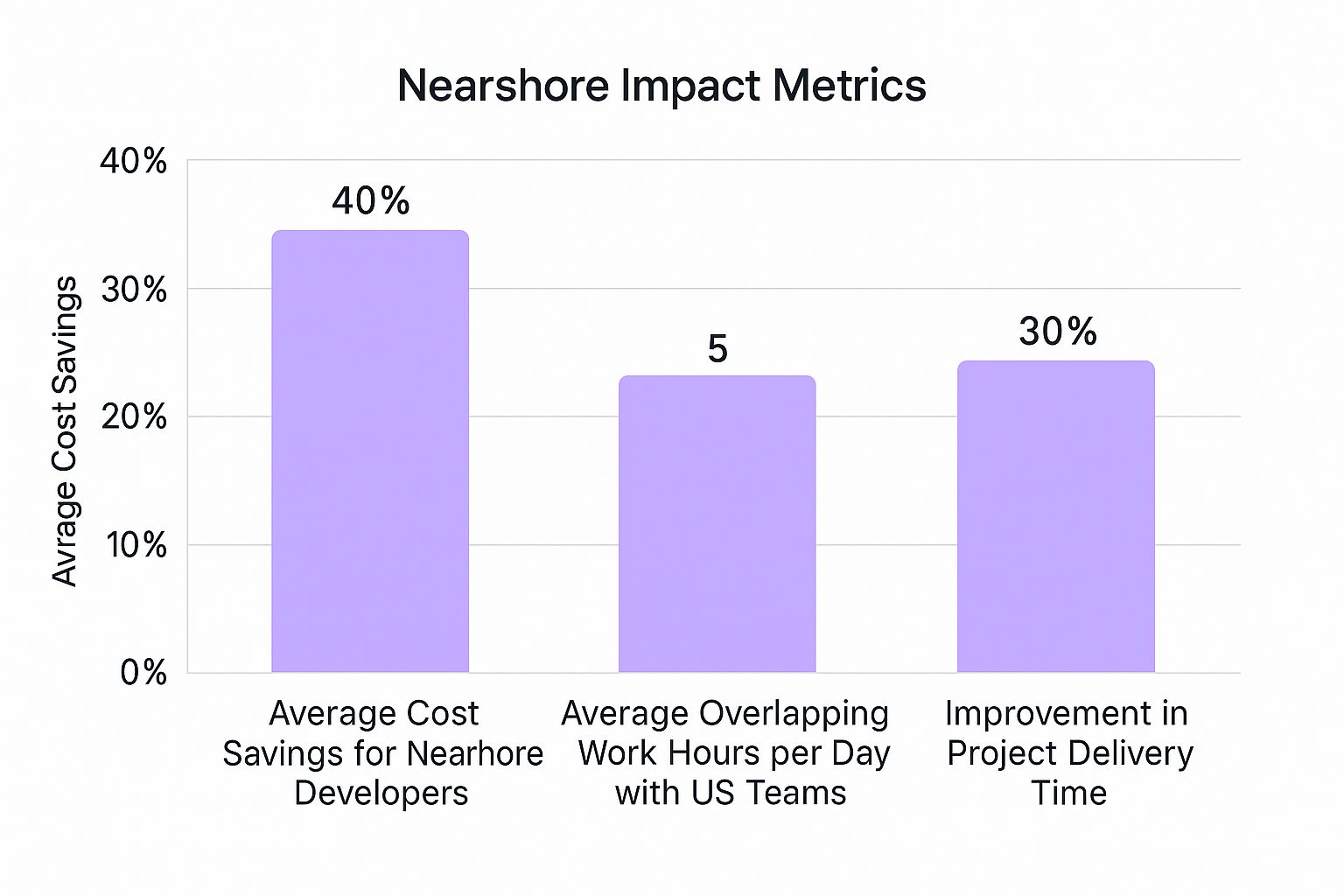
If you want to hire nearshore developers effectively, you need a strategy that goes beyond just cost savings. It’s about building a high-performing extension of your team by prioritizing top talent in nearby time zones. This ensures seamless daily communication and keeps your project cycles moving fast.
The conversation around hiring nearshore developers has changed. It's no longer just a tactic for cutting costs; it's now a core business strategy for getting a competitive edge. The main driver? The unique blend of value and accessibility that nearshore talent, especially from Latin America, brings to North American companies.
This isn't about finding the cheapest labor. It's about finding smarter labor solutions. When your development team operates within a few hours of your own time zone, the whole dynamic of collaboration shifts. You can say goodbye to those late-night calls and frustrating communication delays that often come with traditional offshore models. What you get instead is real-time problem-solving and a much more cohesive, agile workflow.
While the cost savings are certainly a perk, the real power of nearshoring lies in operational efficiency. This model accelerates project delivery because teams can collaborate during overlapping business hours. It creates a more responsive development cycle where feedback is instant and iterations happen much faster.
The data below shows just how much of an impact nearshore partnerships can have on key business metrics.

As the infographic makes clear, nearshoring delivers significant cost savings while dramatically improving project timelines and day-to-day collaboration.
Before you jump in, it’s crucial to understand the key differences between the main outsourcing models. Each one offers a different mix of cost, communication, and collaboration potential. The best choice really depends on your project’s specific needs and your company's work style.
Here's a quick breakdown to see how they stack up.
This table lays out the core differences between the three main software development outsourcing models, comparing them across the business metrics that matter most.
| Factor | Onshore | Nearshore | Offshore |
|---|---|---|---|
| Cost | Highest | Moderate | Lowest |
| Time Zone Overlap | High (8+ hours) | High (4-8 hours) | Low (0-2 hours) |
| Cultural Affinity | High | High | Low |
| Travel Accessibility | Easiest | Moderate | Difficult |
| Communication | Seamless | Very Good | Challenging |
The table highlights why so many companies now choose to hire nearshore developers. It's the sweet spot—the model that offers a balanced approach, giving you major cost reductions without sacrificing the quality of communication and collaboration that’s so vital for success.
The takeaway is that nearshore offers the best of both worlds: notable savings without the headaches of major time zone and cultural gaps.
The strategic appeal is only getting stronger. Recent analysis shows that by 2025, about 80% of North American companies are looking into nearshore development. The model’s rates average 46% lower than onshore, a compelling figure that perfectly complements the primary benefits of time zone alignment and cultural affinity.
Ultimately, this strategic shift is an acknowledgment that a developer's productivity is directly tied to how well they're integrated with the rest of the team. For a deeper look into how remote talent from the region stays so productive, check out our guide on LATAM remote workers and productivity.
When you hire a nearshore developer, you're not just outsourcing tasks. You're investing in a partner who can truly act as an extension of your local team, building a stronger, more agile, and more innovative organization.

Before you even think about where to find nearshore developers, the most important work happens right inside your own walls. If you go to market with a vague job post, you’ll get a flood of vague, unqualified candidates. It’s a classic mistake.
Being absolutely crystal clear about your project and what the role demands is your single best weapon. It attracts top-tier talent and, just as importantly, convinces the wrong people to screen themselves out. This prep work acts as a powerful filter, saving you countless hours of sifting through resumes and conducting dead-end interviews. It's about moving past a simple laundry list of programming languages to build a detailed picture of the person who will actually thrive on your team.
First, start with the big picture. What problem is this project really solving? What are the core business goals? When you truly understand the "why," defining the "what" becomes infinitely easier and more precise.
With a clear vision, you can start mapping out the technical architecture. This isn't just about listing technologies; it's about explaining how they all connect. A senior backend developer role for a microservices architecture is a completely different beast than one for a monolithic app, even if both happen to use Python.
Your tech stack breakdown should get specific:
This level of detail is a magnet for the right people. An expert in AWS Lambda will naturally be drawn to a role that calls it out by name, while someone without that experience will likely move on, saving everyone a lot of time.
Let’s be honest: "Senior Developer" can mean almost anything. Defining the seniority you need goes way beyond just listing "5+ years of experience." It’s about the autonomy, mentorship, and strategic thinking you expect from day one.
Think about what you truly need. Are you looking for a heads-down coder who can execute well-defined tickets? Or do you need a leader who can guide architectural decisions and mentor your junior engineers?
A helpful way to frame this is by contribution:
Putting these expectations directly into your role description ensures you attract candidates who are ready and willing to step into the exact level of responsibility you need them to.
Technical chops get the work done, but soft skills and cultural alignment make sure it gets done well within a team. A developer who communicates poorly or bristles at feedback can poison a project, no matter how elegant their code is.
A classic misstep is obsessing over technical skills while completely ignoring team dynamics. A cohesive, collaborative team will almost always outperform a group of brilliant but disconnected individuals.
To sidestep this trap, define the non-technical traits that are essential for success in your specific environment. Think about qualities like:
A successful nearshore partnership hinges on more than just code. Digging into the science of culture fit in hiring helps you move your evaluation from a simple gut feeling to a more structured way of seeing how a candidate will truly integrate and thrive within your team's unique culture.

Once you've mapped out exactly who you need, the next big challenge is finding and validating that person. When you hire nearshore developers, you're not just casting a line into a small pond; you're tapping into a massive talent pool across Latin America. The real trick is knowing where the best fish are swimming and how to tell the true champions from the rest.
Let's be honest: generic job boards will only get you so far. They're flooded. To find the kind of professionals who will genuinely move the needle for your team, you need a much more focused game plan. This means looking beyond the obvious channels and finding the communities where top developers gather, showcase their work, and build their reputations.
The most effective sourcing strategies I've seen always blend multiple channels to create a strong, consistent pipeline of candidates. If you lean on just one source, you're not only limiting your reach but also risking a homogenous, less diverse group of applicants. A multi-pronged approach is the only way to reliably access both active job seekers and the passive candidates who aren't even looking.
I recommend focusing your energy on these key avenues:
This blended approach means you're not just sitting back and waiting. You're actively hunting for the best talent right where they are.
Finding a promising resume is one thing. Confirming the person has the real-world skills to back it up is an entirely different beast. I've seen slick resumes and charming interviews completely fall apart when it comes time to actually code. That's why a rigorous, multi-faceted vetting process is non-negotiable.
Your goal is simple: get past what a developer says they can do and see what they actually do. This means taking a deep, critical look at their past work and giving them a technical assessment that mirrors the real challenges they'll face on your team.
A critical mistake is using generic, "gotcha" coding puzzles. These brain teasers often test a candidate's ability to memorize algorithms, not their practical problem-solving skills. I've seen great developers fail bad tests, and mediocre ones pass them.
Instead, structure your vetting to get a holistic view of their competence.
A candidate's portfolio or GitHub profile is an absolute goldmine of information if you know what to look for. When you're reviewing their work, dig deeper than just a list of completed projects.
This direct evidence of their work is often a far more reliable indicator of skill than anything they can write on a resume.
The technical assessment is your opportunity to see a candidate in action. Forget abstract puzzles. The best challenges are small, self-contained projects that reflect the actual day-to-day work they'll be doing.
For instance, instead of asking them to reverse a binary tree on a whiteboard, give them a small, broken API. Ask them to find the bug, write a fix, and then add a new endpoint with proper test coverage. This approach tests their debugging skills, their understanding of API design, and their ability to navigate an existing codebase—all mission-critical skills for anyone joining an established team.
The great thing about nearshore development is that these professionals are often at the forefront of modern practices. In fact, many nearshore teams are leading the charge in implementing cloud-native development, from microservices to DevOps. The widespread adoption of Agile methodologies in these regions translates to faster delivery and higher-quality software, positioning them as true partners in innovation. You can discover more insights on how nearshore developers are shaping the future of software development with Arnia.com.
By combining targeted sourcing with a vetting process that tests for real-world application, you create a reliable system to hire nearshore developers who won't just fill a seat, but will genuinely elevate your entire team.

Once you've sourced and vetted your candidates, the interview is where you truly discover if someone can become a valuable part of your team. A great interview isn't a pop quiz or a memory test. It’s a carefully structured conversation designed to reveal a candidate's real-world problem-solving abilities, communication style, and how they’ll mesh with your existing team.
When you hire nearshore developers, the interview process needs to be especially sharp. You’re not just validating skills; you're building a bridge between cultures and work styles. The goal is to move beyond what a candidate knows and see how they think, react, and contribute when faced with a genuine challenge.
Let's be honest: the traditional technical interview often falls flat. Asking a developer to recite an algorithm on a whiteboard rarely predicts their ability to debug a complex production issue at 2 a.m. A much better approach is to simulate the actual work.
This means designing a multi-stage process where each step evaluates a different aspect of their competence. This gives you a complete picture of the candidate, from raw coding ability to strategic thinking and team synergy. A well-rounded process ensures there are no surprises after the contract is signed.
The entire thing should feel less like an interrogation and more like a collaborative problem-solving session. This not only gives you better insights but also creates a positive candidate experience—a must-have in a competitive market.
The first technical stage needs to be all about practical application. This is where you test their core skills in the context of your specific needs. Forget abstract puzzles and give them a problem that mirrors your daily work.
Here are a few formats I’ve seen work wonders:
The key here is to observe their process. Do they ask clarifying questions? Do they talk through their approach? That's often more revealing than the final code they produce.
For any mid-level to senior role, a system design interview is non-negotiable. This session moves from pure coding to higher-level architectural thinking. You're not looking for a single "right" answer. You're looking for a demonstration of their ability to handle complexity and trade-offs.
A typical prompt might be something like: "Let's design a basic URL shortening service like Bitly."
During this discussion, you should be looking for:
This conversation reveals a candidate’s experience with building scalable, resilient systems—a critical skill when you hire nearshore developers who will often work with a high degree of autonomy.
A candidate who can thoughtfully discuss the trade-offs of their design choices is almost always more valuable than one who claims to know a single "perfect" solution. Real-world engineering is about making smart compromises, not finding textbook answers.
The last interview stage should involve members of your existing development team. This isn't just a casual chat; it's a critical assessment of cultural and team fit. You want to see how the candidate interacts with their potential future colleagues.
This interview should center on behavioral and situational questions.
These questions force candidates to draw on past experiences and show you their soft skills in action. After the interview, ask your team for their honest feedback. Their gut feeling is often just as important as any technical assessment.
Of course, after conducting thorough interviews, it's equally important to manage the outcomes professionally. For guidance on topics like handling candidate rejection gracefully, there are great resources that can help maintain your company's reputation.
You found them. The perfect candidate who nailed the interviews, showcased stellar technical skills, and fits right in with your team's culture. Now for the part that often feels like wading into uncharted territory: making the hire official across borders.
When you bring nearshore developers on board, sorting out contracts, local labor laws, and international payroll is the make-or-break final step. A misstep here can quickly unravel into legal headaches, tax nightmares, and a shaky start to what should be a great working relationship.
But get it right, and you’re setting the stage for long-term success. The whole process boils down to understanding your options and being meticulous from the get-go. You generally have two ways to go: engaging developers as independent contractors or working with an Employer of Record (EOR).
The choice between hiring a direct contractor and using an EOR is one of the biggest you'll make. It directly shapes your risk, administrative workload, and costs. There’s no universal "right" answer—the best path depends entirely on your company's size, risk appetite, and what you’re trying to build long-term.
The independent contractor route gives you the most flexibility and keeps upfront costs low. You engage the developer directly through a service agreement, they send you invoices, and you sidestep the maze of local employment taxes and benefits. This model is a great fit for short-term projects or if you're just dipping your toes into the nearshore talent pool.
The catch? The burden of compliance lands squarely on you. Misclassifying an employee as a contractor, even by accident, can trigger serious penalties.
An Employer of Record (EOR), on the other hand, acts as the legal employer for your developer in their home country. The EOR takes care of all the local HR heavy lifting: compliant contracts, payroll, tax withholding, and mandatory benefits. While you pay a service fee for this, it virtually erases your legal risk and administrative overhead. For companies aiming to build a larger, more permanent nearshore team, an EOR is almost always the safer and more scalable play.
No matter which model you pick, a clear, solid contract is non-negotiable. This document is the foundation of your relationship and your first line of defense if something goes wrong. Don't grab a generic template off the internet; your contract needs to be built for a cross-border arrangement.
Make sure these essential clauses are locked down:
A common blind spot is forgetting to account for local labor laws, even in a contractor agreement. Some countries have specific rules that protect contractors in ways that can blur the lines with traditional employment. Always get advice from a local legal expert or use a partner who deeply understands the regulations in your developer's country.
Paying someone internationally isn't as easy as a Zelle transfer. You need a system that’s reliable, cost-effective, and—most importantly—compliant. This is another area where your contractor vs. EOR decision makes a huge difference.
If you hire contractors directly, you’ll need to figure out a payment method that works for everyone. This could be anything from old-school wire transfers to modern payment platforms built for the global workforce. For anyone going this route, it's worth digging into dedicated guides on payment solutions for remote workers in Latin America to see what options are out there.
Figuring out these operational details is why the whole nearshore market is booming. The market, valued at $2.67 billion in 2025, is on track to hit nearly $4 billion by 2034. This growth, detailed in recent nearshore outsourcing market size reports, shows just how confident businesses are becoming in managing these cross-border teams. When you partner with an EOR, they handle all payroll and tax withholding, ensuring you're fully compliant with local laws without any of the guesswork.
The work isn’t over once the contract is signed. In fact, what you do next is arguably just as important. A thoughtful, structured onboarding process is what truly transforms a talented new hire into a high-performing, integrated team member. When you hire nearshore developers, this initial period is your best shot at setting the tone for a successful long-term partnership.
It's a common mistake to think onboarding is just about sending over a laptop and some logins. That approach almost guarantees confusion, slow ramp-up times, and a sense of isolation for your new developer. A great process goes far beyond that; it’s about systematically building connection, clarity, and confidence from day one. The mission is to make them feel valued and ready to contribute meaningfully, fast.
The first month is all about integration and laying the groundwork. Forget about massive code output—the real goal is getting them comfortable with your tools, processes, and most importantly, your people. A clear plan removes the guesswork and empowers them to get up to speed without feeling lost.
Your initial checklist should cover the essentials:
This first phase is all about removing friction. A smooth technical setup paired with early personal connections creates immediate positive momentum.
The ultimate goal of onboarding is to shrink the time it takes for a new hire to feel like an established part of the team. This means intentionally fostering a sense of belonging, not just ticking off boxes on a task list.
As they head into their second and third months, the focus shifts from setup to actual contribution and ownership. This is where you start to see a real return on your investment in finding a great hire.
Your 60-90 day plan should outline clear, tangible milestones:
Seamless integration is a marathon, not a sprint. To keep productivity and morale high, mastering strategies for managing remote teams effectively is critical. The principles you cement during onboarding will shape their entire experience with your company.
For a more detailed blueprint, our guide on the onboarding process for remote employees from LATAM offers specific strategies fine-tuned for the region. By investing in a robust onboarding experience, you ensure the nearshore developers you worked so hard to hire don't just succeed—they thrive.
If you're exploring nearshore hiring, you've probably got a few questions. That's a good thing. Getting clear on the details is what separates a smart strategic move from a leap in the dark. Below are the answers to the most common questions we hear from leaders like you who are looking to build their teams with talent from Latin America.
This is one of the biggest—and most welcome—shocks for companies used to the traditional hiring slog. Forget the months-long process of posting, sifting, and interviewing. When you work with a curated talent platform, you’re tapping into a pre-vetted pool of professionals.
In our experience, you can get a shortlist of qualified, interested candidates within 24-48 hours. This isn't magic; it's the result of continuous vetting. The initial technical screens, background checks, and even language assessments are already done. You get to skip straight to the high-value conversations.
Let's get right to it: hiring nearshore developers is significantly more cost-effective. You can generally expect to pay 40-60% less than you would for an engineer with comparable skills in the United States or Canada.
It's crucial to understand this isn't about getting "cheaper" or lower-quality talent. It’s a simple reflection of the different costs of living in major Latin American tech hubs. This allows you to bring top-tier professionals onto your team without paying the premium salaries demanded by the North American market.
The key takeaway is that you're not sacrificing quality for cost. You're getting access to a global talent pool at a more sustainable rate, allowing you to scale your team more effectively.
This is where many companies get nervous, but the solution is surprisingly straightforward. You really have two paths you can take:
For most companies, especially those looking to scale, using an Employer of Record is the safest and most efficient path. It completely removes the legal and administrative headache, letting you focus on what actually matters: building great products with your new team members.
Ready to stop searching and start building your dream team? LatHire connects you with an elite pool of pre-vetted talent from Latin America. Find your perfect match in days, not months, and let us handle the complexities of payroll and compliance. Start hiring with LatHire today.
